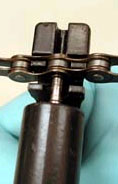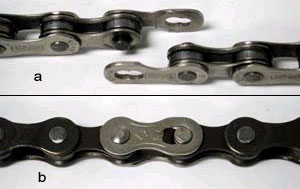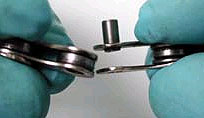Chain Replacement And Repair
|
|
|
Here we explain how to replace a chain on a derailleur-equipped bicycle so that you can install a new chain when yours wears out. Bicycles with derailleurs use a chain that  normally cannot be removed unless you separate one link with a chain tool (photo, left), a special bicycle tool that lets you push a pin out of the chain (more about this procedure later). normally cannot be removed unless you separate one link with a chain tool (photo, left), a special bicycle tool that lets you push a pin out of the chain (more about this procedure later).The techniques used to replace a chain will also help you repair one should you or a riding companion have a problem on the road or trail. For example, as long as you carry a chain tool, it's a fairly simple matter to repair something as serious as a broken chain, which would otherwise leave you stranded. How do you know when to replace a chain? You can purchase the Park Tool Chain Checker and use it, or you can measure the chain for wear. On a new chain you'll be able to measure exactly 12 inches between 2 chain pins a foot apart. If the distance measures 12 1/8 inches or more, your chain is worn out and should be replaced. |
Recommended tools and parts
|
| It's important to check your chain every few months and replace it before it's too far gone. If you just keep riding, you'll wear the chain, cassette and even the chainrings. When you replace your chain regularly, your other drivetrain components last a lot longer, which saves you money. You'll also enjoy smoother shifting and pedaling if you always keep a good chain on your bike. Note that if you wait too long you'll probably need at least a new cassette (or some new cogs) to go with your new chain, and perhaps a new chainring. You'll know this is the case because when you ride your bike with the new chain you'll experience a skipping sensation while pedaling. This skipping is caused by the new chain slipping on worn cogs. Skipping is dangerous and you should replace the cassette immediately. Chain types There are 3 types of chains named and described below. Though there are similarities, each type requires a slightly different technique for replacement. You can click the links below to jump to that type of chain or you may want to read about all of them so you'll be able to replace/repair any chain. That way, if you carry a chain tool on rides, you'll be able to rescue your friends if theirs break. Here are the chain types: Type 1. Chain joined with special replacement pin  On this chain a special pin is inserted that takes the place of a stock pin. This is the way modern Shimano and Campagnolo chains work. The special replacement pin (sometimes 2) is supplied with the new chain so look for it and don't lose it when you open the package. On this chain a special pin is inserted that takes the place of a stock pin. This is the way modern Shimano and Campagnolo chains work. The special replacement pin (sometimes 2) is supplied with the new chain so look for it and don't lose it when you open the package.Type 2. Chain joined with special connecting link (sometimes called a "master" link) Here the chain is joined by a special link that has 2 outer plates with protruding pins that are inserted into the chain rollers, aligned to fit together and then snapped tight by pushing on the pedals. The special connecting link is supplied with the new chain. Look for it in the package. Type 3. Chain joined by any pin The traditional method of joining a chain is to push any pin out just far enough to be able to flex the chain to separate the ends. Though most chains today use the special pins or link, this is still a good thing to understand, because you can use this approach to get home should you break a chain and not have a replacement pin or link for the repair (you should repair the chain correctly when you get home). Purchasing and sizing the chain Once you realize you need a new chain and you're ready to stop riding long enough to replace it, use your chain tool to push any pin completely out of the chain. Chain tools differ. If yours has two grooves for holding your chain be sure to rest the chain so that you're pushing against the sturdier one, which is usually at the back of the tool (photo, right). This is important, because if you seat the chain on the middle groove and try to drive out the pin, you may break that part of the tool. Once the pin is extracted, you can take the chain off the bike. At this point you can count each link to determine how many are on your chain. Or, you might choose to simply bring the chain in to us and let us do the math. Either way, your new chain has to be the same length as your old in order to work correctly on your bicycle. Plus, it must be compatible with your drivetrain. For example, a 9-speed chain should be used with a 9-speed drivetrain, a 10-speed with a 10-speed, and so on. If you have any questions about chain compatibility, just ask. In general it's best to use the same type of chain you had before.
Routing the chain through the derailleurs Be sure the chain isn't resting on anything but the pulleys and that it forms a backwards S (when viewed from the drivetrain side of the bicycle) where it passes through the pulleys (photos, right: notice that in the one marked "wrong," the chain is dragging on a pice of the metal cage). Next, pull the chain through the front derailleur cage and around the bottom bracket (don't place it on the small chainring yet). You should end up with the chain looking like the one in the picture below (with the exception that the chain is resting on the frame, not on a chainring): Joining the chain To prevent this weakness Shimano and some Campagnolo chains use special replacement pins when the chain is installed new or when one is removed and re-installed. These replacement pins have pilots that allow installation without damage to the pin or the outer plate. The pilot is then broken off or removed before riding. These pins come with the chains along with instructions for their use. Tip: It's a good idea to carry a spare pin for roadside repairs. Drive the replacement pin into the chain (this will push the pilot part of the pin out the other side). To make sure you don't push the pin too far, stop and check your progress a few times as you turn the tool. Stop pushing the pin with the tool when the pin end you're pushing on protrudes the same amount as the neighboring pins.
Now that the chain is joined, check the connection for a tight link. It should pivot at the roller without resistance. If it binds, it may cause skipping and shifting problems. To free a stiff link, grasp the chain with your hands straddling the stiff link and flex the chain laterally, which will free the outer plates that got pinched during pin installation causing the stiff link. Campagnolo makes a special tool for installing their chains. If you don't have this tool, it's especially important to press down on the chain at the pin to keep it seated i After the pin is fully inserted, simply pull outward to remove the pilot (photo). Check the freshly connected link by flexing it to feel for tightness that may cause shifting problems. The link should pivot as freely as the others. If not, grasp the chain with your hands straddling the tight link and gently flex laterally to free the link. The special link comes in two pieces (photo a). To join the chain install one piece through the inside face of chain and install the second piece through the outside of the other chain end. Engage the two pieces so that the link pins fit into the special link's plate holes (photo b). Then pull the chain to lock the link. The best way to do this is to place the chain on the chainring and pedal hard by hand to lock the special link. Be sure to inspect the special link before riding to ensure it's securely locked. Note: Some special links are reusable, while others are disposable and should be replaced after each removal. Check the manufacturer's instructions or ask us to figure out which you have.
To join this type of chain, the pin must be in the position shown in the photo below, which is how they come from the factory. To join the ends of the chain, insert the roller end and then slightly flex the chain laterally to get the chain end with the pin to spread a bit wider. At this point you will be able to push and snap the roller end in place as the tip of the pin engages the hole in the roller. The next step is to press the pin into the chain with the chain tool. Push the pin far enough so it protrudes the same amount as neighboring pins. Now that the chain is joined, check the connection for a tight link. It should pivot at the roller without resistance. If it binds, it may cause skipping and shifting problems. To free a stiff link, grasp the chain with your hands straddling the stiff link and flex the chain laterally, which will free the outer plates that got pinched during pin installation. When the new chain is right you'll be able to pedal backwards by hand and the chain will run smoothly around the derailleur pulleys. Repairing a bent chain We proudly use, carry and sell Park Tools. Park has been manufacturing bicycle-specific tools since 1963 and is currently the world’s largest bicycle tool manufacturer. A long-term dedication to quality, innovation, and customer service has made Park Tool the first choice of professional and home bicycle mechanics around the world. This article has been specially edited for us and includes information and photos provided courtesy of Park Tool USA. |
|



 When installing or repairing a chain that uses a special replacement pin, or a chain that uses any pin, keep in mind that most chain failure is due to one of the pins being improperly installed. Modern chains are very narrow, and even a small amount of misalignment in the pin where it sits in the outer plate could cause the chain to break under load. So, always carefully compare the pin you installed to its neighbors making sure they protrude equal amounts.
When installing or repairing a chain that uses a special replacement pin, or a chain that uses any pin, keep in mind that most chain failure is due to one of the pins being improperly installed. Modern chains are very narrow, and even a small amount of misalignment in the pin where it sits in the outer plate could cause the chain to break under load. So, always carefully compare the pin you installed to its neighbors making sure they protrude equal amounts.  The pin will protrude out, towards you. Now place the chain tool on the chain so that the link you're working on is seated completely and resting against the back (strongest) shelf of the tool with the tool's pin aligned to press directly on the special replacement pin when you turn the tool's handle (photo, right).
The pin will protrude out, towards you. Now place the chain tool on the chain so that the link you're working on is seated completely and resting against the back (strongest) shelf of the tool with the tool's pin aligned to press directly on the special replacement pin when you turn the tool's handle (photo, right). To finish installing the pin, break off the pilot, which will snap off if you grab it with pliers and bend. On some chain tools, you can also slip it into the head of the tool and twist to snap it off (photo, left).
To finish installing the pin, break off the pilot, which will snap off if you grab it with pliers and bend. On some chain tools, you can also slip it into the head of the tool and twist to snap it off (photo, left). and the pilot. Engage the pilot and pin (one end of the pin will fit onto the peg on the pilot) so that the pin faces the inside of the bike, toward the spokes (photo, right) and the pilot is inside the link. The pin is then pushed outward, away from the spokes until it's fully inserted in the link.
and the pilot. Engage the pilot and pin (one end of the pin will fit onto the peg on the pilot) so that the pin faces the inside of the bike, toward the spokes (photo, right) and the pilot is inside the link. The pin is then pushed outward, away from the spokes until it's fully inserted in the link. n the chain tool. Use your thumb to hold the link in place as you insert it.
n the chain tool. Use your thumb to hold the link in place as you insert it. Some chain manufacturers offer a special link (sometimes called a "master link"), to join the chain. Because designs vary, be sure to read the directions or ask us. Typically, the bicycle chain ends must have rollers on each end. In other words, neither chain end has an outer plate with a pin.
Some chain manufacturers offer a special link (sometimes called a "master link"), to join the chain. Because designs vary, be sure to read the directions or ask us. Typically, the bicycle chain ends must have rollers on each end. In other words, neither chain end has an outer plate with a pin.
